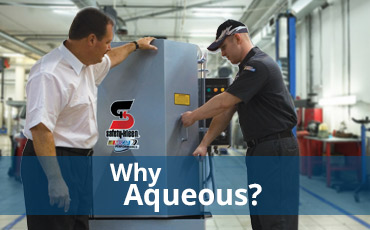 Parts cleaning is important – and necessary – to organizations that manufacture, repair, and maintain parts and equipment. So, it’s equally as important that the right products and processes are chosen.
Parts cleaning is important – and necessary – to organizations that manufacture, repair, and maintain parts and equipment. So, it’s equally as important that the right products and processes are chosen.
It’s not quite as simple as it sounds, though.
Back in 1984, a series of Hazardous and Solid Waste Amendments led The United States Environmental Protection Agency to set some new guidelines for waste reduction associated with metal parts cleaning operations.
As companies set out to find alternatives to the traditional solvents and chemicals that were being used in parts cleaning, which resulted in air emissions, wastewater discharge, and hazardous waste, they stumbled upon aqueous-based cleaning solutions.
Aqueous cleaning chemistries range from highly acidic, to near neutral, to highly alkaline, each chemistry geared toward different soil removal.
Alkaline chemistries are typically used to remove organic soils like oil, grease and coolants, and more neutral chemistries work better when used along with mechanical energy systems.
The most basic aqueous cleaner, as its name suggests, is water, which can be used along with high-pressure systems to remove grime. These cleaners typically work by displacing soils, rather than dissolving them like organic solvents do. However, many soils will require something a little more potent than water alone.
Since aqueous cleaners come in different forms (alkaline, acidic, chelating agents), they are composed of different chemicals.
Acidic cleaning varieties can be comprised of mineral acids like nitric and sulfuric acids, organic acids like sulfamic and citric acids, as well as detergents and chelating agents. These work at removing oxidation scale and rust from metals.
Alkaline varieties, on the other hand, can contain sodium salts of phosphates, carbonates, silicates, and hydroxides, as well as soap, and even anti-oxidants and stabilizers. These work at removing heavy oils and even solid soils. One such highly alkaline cleaner, the Armakleen M-301 acts as a rust inhibitor and is used for cleaning heavy soils from ferrous metals.
Aqueous cleaning methods that have proven most effective in soil removal include immersion, ultrasonic, spraying and steam cleaning.
One of Armakleen’s main aqueous cleaning chemistries, the 4 in 1 Cleaner, can be used in all of these cleaning methods, including manual, immersion, ultrasonic, and spray techniques. The solution is incredibly concentrated and is actually used at half the concentration of single-purpose cleaners. Typically, it’s used to remove light to medium soils, but it also acts as a temporary indoor rust protector during times of storage.
When it comes to cleaning with aqueous solutions, it’s important to remember that no product on its own will combat the soil. There are a variety of factors that go into the cleaning process. Four things to remember when it comes to metal parts cleaning with aqueous solutions: temperature, agitation, concentration, and time.
Some chemistries work best at certain temperatures, while others require movement, like ultrasonics or immersion, to reach peak performance. It’s also important to remain educated on your cleaner since most are not used at 100% concentration and need to be mixed with water in order to be most effective.
Once you select the right cleaner and use it properly, you’ll probably save yourself some time! And who couldn’t use more of that!
Source:
Environmental Protection Agency. Waste Minimization in Metals Parts Cleaning. Washington D.C.: Office of Solid Waste and Emergency Response, 1989. Print.




